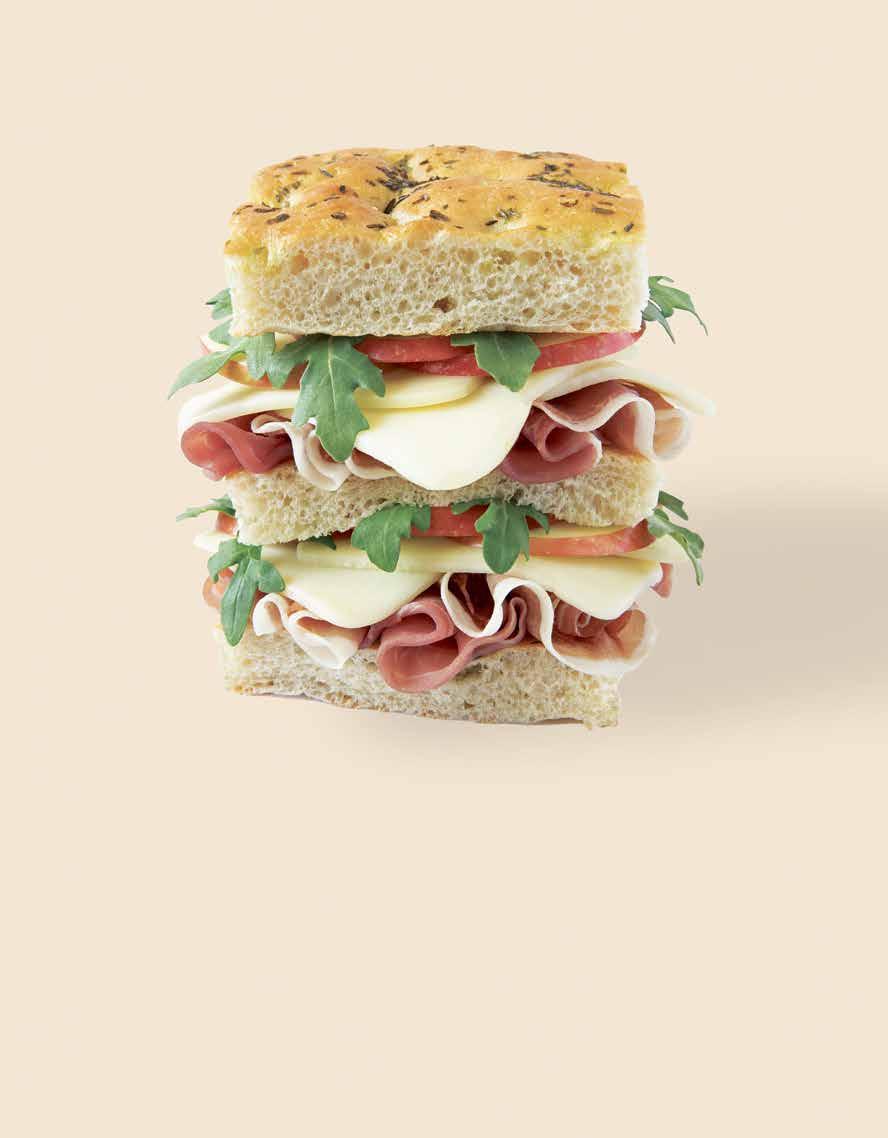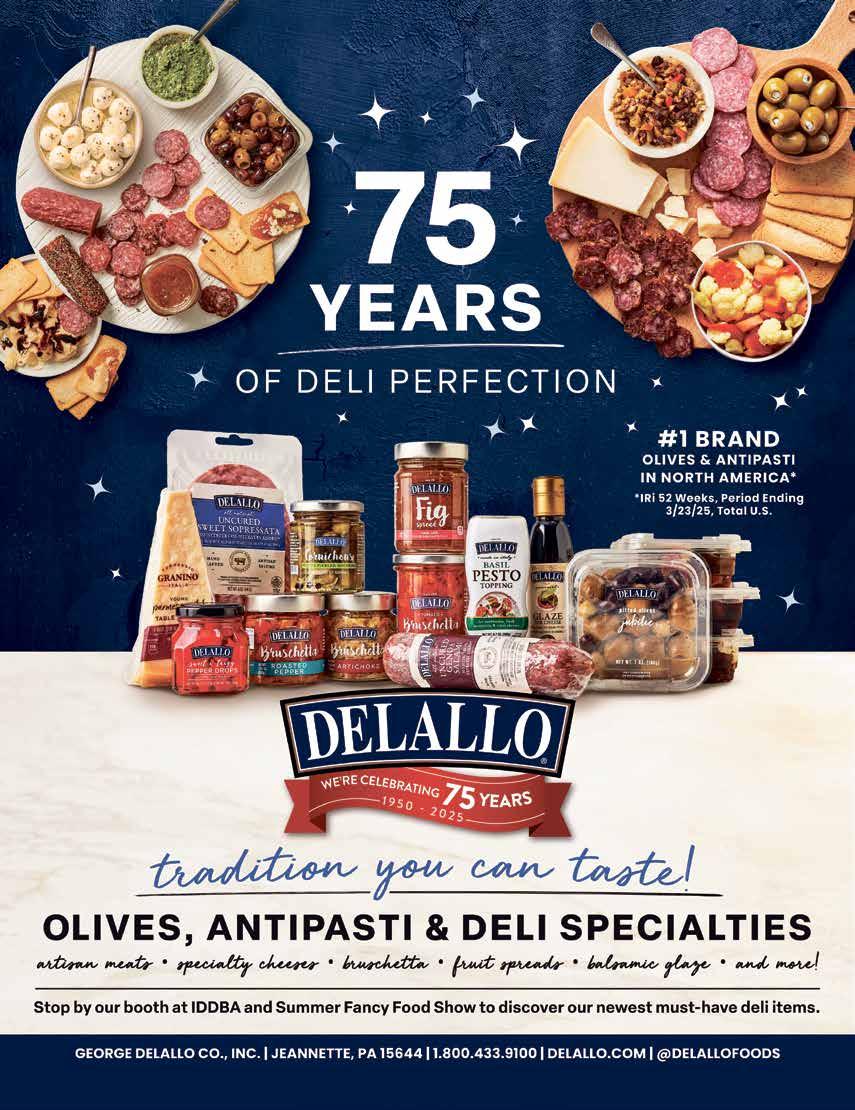



































Deli Business honors the best of the best in the industry.



MARKETING
PUBLISHER/EDITOR-IN-CHIEF
kenneth l. whitacre kwhitacre@phoenixmedianet.com
INDUSTRY LIAISON
lee smith
MANAGING EDITOR
aimee tenzek atenzek@phoenixmedianet.com
ART DIRECTOR
jackie tucker jtucker@phoenixmedianet.com
CONTRIBUTING WRITERS
carol bareuther
tom gresham
bob johnson
sarah louise klose
keith loria
lisa white
ADVERTISING & MARKETING
leslie levy llevy@phoenixmedianet.com
send insertion orders, payments, press releases, photos, letters to the editor, etc., to:
deli business
p o box 810217, boca raton, fl 33481-0217 phone: 561-994-1118 fax: 561-994-1610 email: info@delibusiness.com
PHOENIX MEDIA NETWORK, INC.
president/ceo
kenneth l. whitacre
general counsel debra prevor
deli business is published by phoenix media network, inc
p.o. box 810425, boca raton, fl 33481-0425 phone: 561-994-1118 fax: 561-994-1610 www.delibusiness.com entire contents © copyright 2025
phoenix media network, inc all rights reserved printed in the u s a publication agreement no. 40047928






WELCOMES MARY
BETH
The Specialty Food Association (SFA), New York, NY, announced that Mary Beth Vultee has joined the organization as senior vice president, membership, a newly created position. Most recently at Whole Foods Market as executive leader of design, Vultee is a former chef with a master’s in food studies from New York University. She began her career in the kitchen before transitioning to key roles in the industry, including as a national sales manager at The Chef’s Warehouse. Her time at Whole Foods Market further shaped her expertise in product development and mentoring emerging brands. www.specialtyfood.com

BelGioioso, Green Bay, WI, and Polly-O have earned top honors during the 2025 U.S. Championship Cheese Contest Judging. BelGioioso’s new Marinated Fresh Mozzarella with Fresh Basil and Garlic was awarded first place in the category and a top 20 finish overall. BelGioioso’s Sharp Provolone Mandarino received first place in the Aged Provolone category. Polly-O claimed first place in the String Cheese category. Additionally, BelGioioso’s Asiago Fresco earned second place, and Polly-O’s NY Style Ricotta earned third place. www.belgioioso.com

Kristal Sevcik, vice president of business development at AmeriQual Group, LLC, has been re-elected chairperson of the Private Label Manufacturers Association’s Board of Directors at the annual meeting. Sevcik was first elected to the position in 2024 and now will serve a second one-year term. Executive officers were also re-elected for second one-year terms: Mark Cheney, Upstate Niagara Cooperative, Inc., as first vice chairperson, and Anthony Biggers, Simmons Pet Foods, as second vice chairperson. Additionally, seven new directors were elected for three-year terms, from 2025-2028. www.plma.com

Wyke Farms is introducing Ivy’s Reserve Salted Farmhouse Butter into the U.S., exclusively available in select Whole Foods Market stores from now through August. Crafted with fresh cream, this award-winning butter is made in Great Britain and gently churned to create a smooth, rich, and clean flavor profile. It is available in 8-ounce blocks. For over 160 years, Wyke Farms has been producing cheddar in Somerset, England. www.wykefarms.com

Nicola Bertinelli has been unanimously reappointed president by the board of directors of the Parmigiano Reggiano Consortium. Bertinelli will lead the consortium for another four-year term, with Daniele Sfulcini serving as vice president. The executive committee members were also appointed: Luca Cotti and Giuseppe Scarica (Parma), Giorgio Catellani and Giuseppe Alai (Reggio Emilia), Emilio Braghin and Andrea Lori (Modena), and Giulio Ghiaroni (Bologna). www.parmigianoreggiano.com

CAPUTO CHEESE WINS BIG AT THE 2025 US CHAMPIONSHIP CHEESE CONTEST
Caputo Cheese, Chicago, IL, won “Best of Class” with its Bocconcini in the Fresh Mozzarella category and second with its 1-ounce Fresh Mozzarella Slices in the Natural Sliced Cheese category at the U.S. Championship Cheese Contest. Bocconcini is a fresh mozzarella that is stretched and kneaded into small, bite-sized balls. Caputo Cheese’s 1-ounce Fresh Mozzarella Slices are ideal for sandwiches, panini and pizza. Each slice is shaped individually. www.caputocheese.com
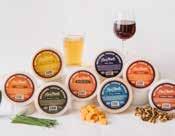
Ronin Equity Partners, in partnership with Landon Capital Partners, announced the sale of Barron, WI-headquartered Heartisan Foods to The Gellert Global Group. The Gellert Global Group owns a specialty cheese subsidiary, Atalanta Corporation. Ronin and Landon formed Heartisan in June 2021 through the acquisition and integration of three market leaders in specialty cheese: Red Apple Cheese, Barron County Cheese, and Cheese Brothers. North Country Packaging was acquired and integrated by the Heartisan platform in June 2023. www.roninequitypartners.com

Cedar’s Mediterranean Foods is bringing bold new flavor to the table with its latest limited-time release: Topped Organic Garlic Sweet Chili Hommus. This seasonal dip combines Cedar’s smooth and creamy Organic Hommus with a sweet chili sauce and a punchy garlic-forward seasoning blend. Crafted in small batches with certified organic, vegan, gluten-free, and non-GMO ingredients, this newest addition to Cedar’s lineup is made for summer moments. www.cedarsfoods.com







Deli Business honors those who have made a significant contribution to the industry, their company and their community. These changemakers are the visionaries, the innovators and the passionate advocates who are committed to driving change in the deli industry.

Q. Can you tell us a bit about your upbringing and how it has shaped you?
In 1979, my father and mother, with my sisters and I in tow, moved to America to start a new life. Along with my father he brought our two head cheesemakers, Mauro and Gianni, to continue the family legacy and start crafting Italian style specialty cheeses here in America.
As a child, I remember going to the cheese plants with my father on the weekends. He would teach me the importance of doing things right and not cutting corners. He would say, it’s easy to make a good cheese once, the challenge, and our goal, is to make great cheeses consistently, day in and day out.
Over the summers in high school, I worked in the plants and learned how to make cheese and take care of it. I cleaned cheese drying racks, flipped American Grana wheels on wood aging boards, and packed a lot of fresh mozzarella over that time.
While the work was hard, it was rewarding. At the end of the day, I could see the fruits of my labor on the dinner table in my mom’s delicious dishes.
Q. What were some of the pivotal moments that led you to where you are today?
Growing up in a family cheese business, there had always been somewhat of an expectation to come back and work in the business. I went to college in Chicago, then after graduation, I moved out East, working in consulting and getting some outside experience.
In the back of my mind, however, going back to the family business was always calling me.
Q. How has your career evolved over the years?
I started working at BelGioioso in 2000. I began on the operations side of the business, working closely with our plant managers and cheesemakers on improving quality and efficiency and helping bring new lines and new products to life.
After that, I was involved with the sales side of the business. I traveled to visit our broker partners, met with customers and attended national trade shows. This was a whole new world for me, and very exciting to learn and be a part of.
There is nothing better than getting out into the market and seeing your cheese beautifully merchandised on the shelves of a retailer or served on a tasty dish in a great restaurant.
It is great to hear directly from customers on what they see as opportunities and challenges. Working hand and hand with our
customers, brokers and sales managers to grow and expand our cheeses in the market is very rewarding.
Q. What is the best advice you ever received and why?
One of the guiding principles I learned early on from my father, and echoed by our head cheesemakers, is that everything we do is “per il bene del formaggio” (for the good of the cheese).
What this means is that whatever decision we make from a production change, ingredient change, or efficiency change, should be made under the lens of making sure it is for the good of the cheese.
The change must improve the consistency or quality of our finished cheese for us to make it. We are not interested in saving a few pennies if it means the quality will be compromised.
Q. What deli retail trends have impacted the industry most over the last year?
In my opinion, we have been seeing a surge in consumers looking for higher quality, artisanal cheeses. People are traveling the world and when they come back, they want to experience the flavors of the cheeses they had abroad. A great specialty cheese is an affordable luxury. It is something you can treat yourself to and not break the bank.
Another trend we are seeing is healthy snacking. We have seen a large increase in demand for our snacking line of cheeses, like Fresh Mozzarella, Parmesan, Fontina, Mild Provolone, Artigiano and Asiago Fresco.
More people are moving away from sugary snacks with empty calories. Our snack cheeses are a great source of protein and calcium and are filling and very satisfying.
Q. What hobbies do you enjoy outside of work?
Outside of work, I enjoy going on hikes with my family. I love being out in nature — it is calming and energizing.
My other passion is road cycling. I love being out in the countryside, and experiencing the sights and sounds of summer.
Q. Where is your favorite place to go on vacation?
My favorite place to go for vacation is Italy. As a child I spent my summers there with family and friends. Going back now with my family helps me reconnect with my heritage and eat some great food! It is also interesting to walk the supermarkets there and see the latest cheese trends and packaging innovations.

Q. Can you tell us a bit about your upbringing and how it has shaped you?
Growing up in the cheese industry was a lot of fun. As I kid, I would often tag along to work and help staple product guides or just run around the warehouse. It has always been great working with my dad and also running into all my cousins and uncles at the various food shows.
I remember any time we went on vacation, my family’s first stop would often be a supermarket cheese section. This drove me crazy as a kid.
On my first trip without my parents, I found myself in a supermarket with the person I was dating at the time, and it hit me that everything had come full circle. Food, especially cheese, was something I loved, and always had on my mind.
Q. What were some of the pivotal moments that led you to where you are today?
In early 2010, we purchased Crystal Foods. This was only a few months after my mom passed away from cancer. This period had a huge impact on both my personal life and career.
I really went all in on work at this time, as it was a great distraction.
I always had a solid understanding of the logistics side of cheese distribution, but Crystal Foods was really the best of the best, in terms of product selection.
Getting to work side by side with John Ciano, Stephanie, and the team they had there, really exposed me to this new world of specialty cheese. I always loved food, and to get to now work with these amazing products and go on international sourcing trips for the first time was heaven.
I was hooked.
Q. How has your career evolved over the years?
It’s been a great ride. At first, it was very focused on single job functions, and then it grew to seeing the big picture that I do now. From working in the warehouse in middle and high school, to sales and marketing in college and after, to being able to oversee the interconnection of our California and New York offices in the birds-eye view that I have today.
Q. What is the best advice you ever received and why?
My first non-cheese job out of college was working as a cold caller for a team of stockbrokers. My boss at the time was very successful and would only partially joke, “I have no idea what I am talking about half the time, but I always make sure to surround myself with the smartest people, and I know to go to them when I need to.”
We have tried hard to build a great team here. As a business owner, it is not always easy to let go or get help from others. I would say I am still working on following this advice.
Q. What deli retail trends have impacted the industry most over the last year?
Well, hopefully it is not a shift away from international products due to tariffs!
I think even after COVID, staffing is still an issue, and the need for “retail-ready” items is not going away.
At the same time, specialty shops and supermarkets don’t want to just be copies of each other, so the demand for “something different” is still there, and customers are still hungry to find exciting new items.
For us, this has been great, as we have a lot of unique artisan items that the larger distributors do not have.
Q. What hobbies do you enjoy outside of work?
I have a 3- and 4-year-old, and they are just starting to really get into fun stuff, like riding bikes, building forts, and making up their own games. I love playing with them whenever I can.
My wife and I are also still doing a good job of making it out to concerts or restaurants. It’s been a big change since before COVID. Hopefully, we can keep that up and not turn into old people too quickly.
Q. Where is your favorite place to go on vacation?
A quiet beach where I can hear waves and not a single other sound. It’s what I think about all holiday rush just to keep me going. The second we are done with Q4, inventory, and the Fancy Food Show, I try to get away to reset, even if it’s just for a weekend.

Q. Can you tell us a bit about your upbringing and how it has shaped you?
I was fortunate to have a strong support system growing up, especially from my dad, who was my biggest cheerleader. He always made me believe I could accomplish anything and never treated me differently from my brothers. I was given the same opportunities and often pushed myself even harder to prove what I was capable of.
My parents instilled a strong work ethic in us from an early age, which has shaped my approach to both my personal and professional life. I strive to give my best in everything I do and continuously aim for self-improvement.
Q. What were some of the pivotal moments that led you to where you are today?
One of the most defining moments in my life was becoming a mother during my junior year of high school, which led me to drop out. At the time, it was devastating. I had planned to be the first in my family to attend college. I dedicated the following years to raising my children, but when my oldest son reached his senior year, I realized I needed to lead by example. In 2014, I began working on my associate degree, and by 2023, I had earned my Master of Business Administration.
My son ultimately chose to serve in the Marine Corps, which further inspired my passion for supporting veterans. He has since earned a degree in bioengineering, making me even more proud of the journey we both took.
Q. How has your career evolved over the years?
I spent 17 years working at Dunkin’ Donuts, where I worked my way up to a management role. The flexibility allowed me to balance work and family until I was ready to transition into a corporate career.
In 2013, I joined Ahold in the payroll department and steadily advanced through various roles. In 2019, I transitioned to merchandising with Stop & Shop, specializing in specialty deli as a category analyst. I was promoted to assistant category manager in 2021 and, most recently, to category manager in 2024.
Twelve years later, I’m grateful I chose to build my career with this company. The strong commitment to community support continually inspires me and makes this a truly rewarding place to work. I especially love working in the cheese category. It’s more than just a product; it’s something that brings people together, creating moments of joy and connection.
Q. What is the best advice you ever received and why?
The best advice I’ve received is to not take myself too seriously. Mistakes are inevitable, but they are also opportunities for growth and learning. The key is to embrace them, take lessons from them, and even laugh at them once the moment has passed. If you take yourself too seriously, you may miss out on truly enjoying the journey.
Q. What deli retail trends have impacted the industry most over the last year?
The industry has faced significant challenges, particularly with recalls and inflation. Both have had a major impact on business operations and consumer behavior. Additionally, with the potential threat of tariffs, we are closely evaluating our imported product selection and assessing how to navigate these changes, while continuing to provide quality products to our customers.
Q. What hobbies do you enjoy outside of work?
I enjoy gardening, working out, hiking, and, of course, petting every dog I meet along the way. In October, I completed my first — and last — marathon, which has officially removed running from my hobby list!
Q. Where is your favorite place to go on vacation?
I love traveling to tropical destinations where I can relax and enjoy the warm weather and the ocean, but I also appreciate a good staycation. Sometimes, there’s nothing better than enjoying the comforts of home.

Q. Can you tell us a bit about your upbringing and how it has shaped you?
I am Spanish and growing up, food was at the center of all family events, big or small. My great-aunt commonly watched me when I was off from school and my parents needed to work. The memories I have of spending time in her kitchen, learning to cook empanadas and tostones, are very dear to me.
While she and I had the opportunity to make food from scratch, I recognize that is not always possible in today’s fast-paced culture. Therefore, taking care to make sure I am putting the best version of an item in front of our customers is very front of mind when I’m developing a new item.
Q. What were some of the pivotal moments that led you to where you are today?
I grew up a musician and went to college for music, receiving bachelor’s and master’s degrees in the field, and even started work on a Ph.D. in music theory and analysis. Digging into the why a particular piece of music sounded a certain way or elicited a reaction from an audience was a core part of my academic studies — my earliest data deep dives.
While in graduate school, I worked for a large clothing chain for several years. I encountered a pivotal point in my academic studies as I completed my coursework but was still several years away from defending a dissertation, where I was offered a full-time job as an associate store manager. This opportunity was unexpected but offered stability and a career change that was very welcome.
Q. How has your career evolved over the years?
I began my retail career working for the large clothing chain mentioned above. I started as a store associate while in graduate school and worked my way up to assistant store manager. I needed to quickly learn how to manage a business, while prioritizing customers in store, keeping shelves and racks full, leading a team, and many other critical tasks. As a store manager, I had the opportunity to listen to corporate strategy meetings, learning more about the “why” behind assortment and design decisions. I found this side of the business to be quite intriguing and set out to move into a strategic merchandising role.
My path to my current role included a several-year stop at a service provider to Kroger, where I had the opportunity to work in digital and data integrity roles. Bringing together these experiences with five years spent in-store has shaped who I am today — a datadriven strategic manager still looking to put customers first.
Q. What is the best advice you ever received and why?
“It’s OK to let cracks show.” As a perfectionist, I am highly motivated to not drop any balls or let mistakes show, and in the fast-paced, ever-changing grocery environment, appearing perfect is very challenging. I constantly remind myself that mistakes are OK, and all I can do is my best in that very moment. This mindset shift has helped me to better execute during stressful times.
Q. What deli retail trends have impacted the industry most over the last year?
As our mainstream customer continues to balance price with quality, all on an ever-tightening budget, we must be customer-focused when making decisions, ranging from retail strategy to quality to assortment choice. Our customer is trying to do more with less, and to keep them in the deli, we must present them with a special eating experience that can only be found in this section of the store. Customers are also more aware of food safety now more than ever; they are going to spend their dollars on products they feel secure in purchasing. As merchants, we need to take extra steps to ensure customers are being presented with products of the utmost quality, whether that be additional product paneling, ongoing safety and quality checks, or keeping very open lines of communication with our supplier partners.
Q. What hobbies do you enjoy outside of work?
I enjoy getting outside and going hiking, trying new restaurants, especially while traveling, and spending time with my husband and our four cats. I’m also an avid reader and usually have a couple of library books on hand.
Q. Where is your favorite place to go on vacation? Asheville, NC. I love an eclectic city close to mountains and beautiful hiking trails.

Q. Can you tell us a bit about your upbringing and how it has shaped you?
I grew up in 1980s Minnesota with parents who were, for their time, nascent foodies. Gourmet or unusual ingredients were not widely sold so we kept it simple — the priority was always homecooked, healthy-ish meals. We didn’t go out to eat much, so the goal was always to recreate those special meals as best we could. I remember my mom sternly telling me, the budding cooking enthusiast, to not use her balsamic vinegar since it was comparatively expensive to use in everything!
Even as a kid, I had a thing going for cheese. By the time I got to high school, I was always tasked with putting together the holiday cheese plates, which, in retrospect, were probably pretty quaint.
Q. What were some of the pivotal moments that led you to where you are today?
After my first shift in the cut-to-order cheese shop I started at, my manager handed me a copy of Steve Jenkin’s “The Cheese Primer” to start getting more knowledge under my belt. I think I read it cover to cover in about two days and then went out to spend $30, that I absolutely did not have as a poor college student, on cheese at a specialty shop near my apartment. I literally did not even want to wait for my next shift to just grab samples. That was when I knew I may have found my career path.
The other big one was in 2011, after I joined the team at Whole Foods Market. We went to Chicago for a regional meeting, and it was the first time I met Cathy Strange in person. I had followed her for years on social media and remember fangirling to her about how excited I was to finally meet her. She was gracious and, given her tall stature, truly larger than life! I still get star struck and nervous whenever I get to talk to her.
Q. How has your career evolved over the years?
I spent the first six years of my career behind a cheese counter really talking to customers about what they were looking for, what they liked, what they didn’t — and I have carried that with me since. Producers and styles may come and go through the years, but what makes a cheese popular and easy to sell, remains the same.
When I made the move to Whole Foods Market in 2010, I only spent 18 months behind the counter before moving into a new position where I was able to start sharing my accumulated experience with a wider group of people.
In 2017, I made the leap to purchasing for an entire regional area. Customers have a lot of commonalities, but the nuances at the local store level are endless and incredible. Now that I’m making assortment decisions for an entire country’s worth of stores, I lean on expertise from the amazing mongers and suppliers in these areas to understand who they believe the specialty cheese customer is and what they’re looking for.
Q. What is the best advice you ever received and why?
Stay humble, hustle hard. Some of my favorite people in this industry embody this, and I strive to emulate it as best I can. It costs nothing to work hard and stay grounded.
Q. What deli retail trends have impacted the industry most over the last year?
We’ve seen a lot of movement toward pre-pack/exact weight formats. While I can appreciate the convenience and simplicity of this format, there is simply no substitution for freshly cut cheese from a wheel. As Cathy Strange would always remind us: “Cheese is alive!”
Exact weight cuts can preclude styles that we don’t see as widely produced domestically, such as washed rinds and soft-ripened offerings — my worry is that it will ultimately narrow customer familiarity with this wider range of styles.
Q. What hobbies do you enjoy outside of work?
During the summer months, I take up residence in my garden (I’m a University of Wisconsin-Extension Master Gardener). During the colder winter months, I’m an avid embroidery enthusiast, clarinet player and sourdough baker.
Q. Where is your favorite place to go on vacation?
I love going up to Lake Superior during the hottest weeks of the summer — so refreshing!

Q. Can you tell us a bit about your upbringing and how it has shaped you?
I grew up in a supportive and nurturing environment where my parents emphasized the importance of education, hard work and integrity. They invested everything they had to provide my siblings and me with the best education possible. Raised in a humble family setting and surrounded by many of my cousins, I was fortunate to experience a strong sense of community and familial support.
My parents encouraged me to pursue my passions and ensure that I found joy in every step of the journey. Through these experiences, I learned the value of teamwork and the power of collaboration, which have been instrumental in shaping my leadership skills. These lessons have enabled me to work effectively with and lead numerous diverse teams, promoting strong professional relationships.
My family, especially my grandparents, taught me the importance of staying true to one’s values. I believe I am fundamentally the same person I was 16 years ago when I began my professional career. While I have grown and matured significantly, the foundational principles that drive me to become a better person each day remain unchanged.
I consider myself a lifelong learner. Whether through formal education or personal hobbies, I am always seeking opportunities for growth. This mindset drives me to remain curious and proactive in my career, constantly enhancing my skills and knowledge.
Q. What were some of the pivotal moments that led you to where you are today?
I have always been driven by a desire to help others. Since beginning my retail career 16 years ago, I have been passionate about providing people with access to quality food at affordable prices and offering them a culinary journey through diverse flavors. Through traveling, I have witnessed the unifying power of food, and I strive to develop products within our brands that bring people and families closer together.
Furthermore, I recognize our responsibility to leave a better world for future generations. As a father, this commitment is deeply personal, and I constantly remind myself of this responsibility when developing new products. I am dedicated to continuing my work with a focus on creating excellent products, while adopting a more healthy and environmentally friendly approach.
Q. How has your career evolved over the years?
I am fortunate to work for a company that believes hard work
can lead to any role within the organization. Walmart provides the opportunity to gain exposure to various sides of the business across multiple departments. Throughout my tenure, I have gained a comprehensive understanding of our supply chain operations, developed strong relationships with suppliers, and driven business growth for both parties. I have also partnered with and nurtured niche suppliers into key partners, contributing to the growth of essential business areas for the company. Additionally, I have had the privilege of developing high-quality, affordable food for customers.
By understanding the entire process — from sourcing products directly from fields or farms to converting, producing, shipping, and selling them to customers, I am better equipped to help people save money and live better lives.
Q. What is the best advice you ever received and why?
“Those who learn how to listen well will change the world when it is their turn to speak.”
Q. What deli retail trends have impacted the industry most over the last year?
In our fast-paced lifestyle, many of us often prioritize convenience over enjoying a flavorful meal, opting for quick calorie consumption to keep up with busy schedules. This has led to a trade-off between taste and time. However, over the past year, I have noticed a significant shift in the approach of brands and retailers. They have been focusing more on enhancing flavor profiles, both regionally and internationally, with offerings such as Nashville Hot, Mediterranean and Caribbean cuisines.
Additionally, retailers and brands are innovating by incorporating nontraditional ingredients, like ginger, black garlic and beet powder, successfully balancing premium ingredients with an accessible and enjoyable eating experience.
Q. What hobbies do you enjoy outside of work?
I have a passion for traveling and discovering new destinations and flavors around the globe. Each year, my family and I visit a different country, immersing ourselves in its culture and culinary experiences. Additionally, I enjoy outdoor activities such as running, biking and hiking.
Q. Where is your favorite place to go on vacation?
Anywhere I have never been to! Life is too short, and I like to explore new places all the time.
DB


Conroy Foods, makers of Beano’s deli condiments, has been making sauces and merchandising them in deli sections across the nation since 1986. They’ve successfully utilized shippers as a merchandising tool to become a fan favorite in the deli section today.
Floor space in the grocery store, and especially the deli department, is very valuable, so Conroy designed a shipper with a compact 14 x 20-inch base that holds 4 cases of product. Each shipper can be customized with the header card art — sure to catch shoppers’ eyes with key seasonal themes.
Conroy uses full-color, eye-catching header cards to complement shippers full of a bold variety of sauce flavors. More and more retailers have a pre-packed deli area for the consumer who does not want to wait in line. Merchandising condiments right above the grab-and-go case is a great spot to add a variety of Beano’s flavors to inspire sandwich creativity. Shoppers love condiments with a deli sandwich, but Beano’s Honey Mustard also pairs great with soft pretzel bites and the new Nashville Hot Sandwich Sauce goes awesome with deli case chicken tenders. Snack boards are also on-trend, so positioning near the olives and cheese will entice shoppers to add another level of flavor to their boards.
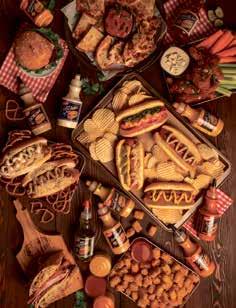
Seasonal shippers are available year-round with the following themes: Everyday, Winter Holiday, Easter, Summer Sizzle, Patriotic, Tailgate and New Nashville Hot. Each shipper comes with a seasonally relevant selection of 4 cases of product (48, 8oz bottles). Some flavors do better during certain times, for example, Cranberry Honey Mustard and Horseradish sauces do really well during the holidays to pair with turkey and beef dishes. The All-American Sandwich Sauce does well during the summer grilling/burger season.
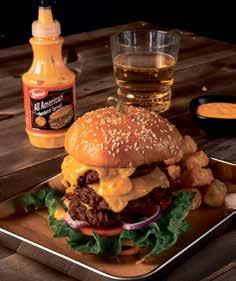
Shippers are self-con tained in one box and easy to assemble — it takes 3-5 minutes to build and includes 4 shelf-ready packages of product.
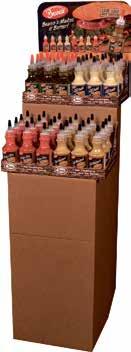
• Cross-promote with other deli sandwich ingredients
• Don’t stop at sandwiches! Co-promote with chicken tenders, pretzel bites and party trays!
• Line-price to promote together and drive trial
Good cross-merchandising should deliver a convenient experience to the shopper, as well as increased revenue for the retailer. Busy shoppers with kids’ lunches in mind will select sliced meats and cheeses, and while they are waiting for their deli order, retailers can position Beano’s condiments with bread rolls or flatbreads to simplify the shopping experience. Now, shoppers who were only going to get sliced turkey are inspired to make a bolder, more flavorful sandwich by picking up Beano’s unique sauces.
Expanding pairing possibilities is key when thinking about creative cross-merchandising opportunities, wherever shoppers purchase sandwich-making components. Other examples would be merchandising Beano’s Honey Mustard or New Nashville Hot Sandwich Sauce on endcaps or display by the frozen chicken nuggets. Having a display of Beano’s Horseradish Sauce by the meat case when beef is on sale will surely create incremental sales. With shelf-stable condiments and a free-standing and movable display, they can be placed anywhere in the store.

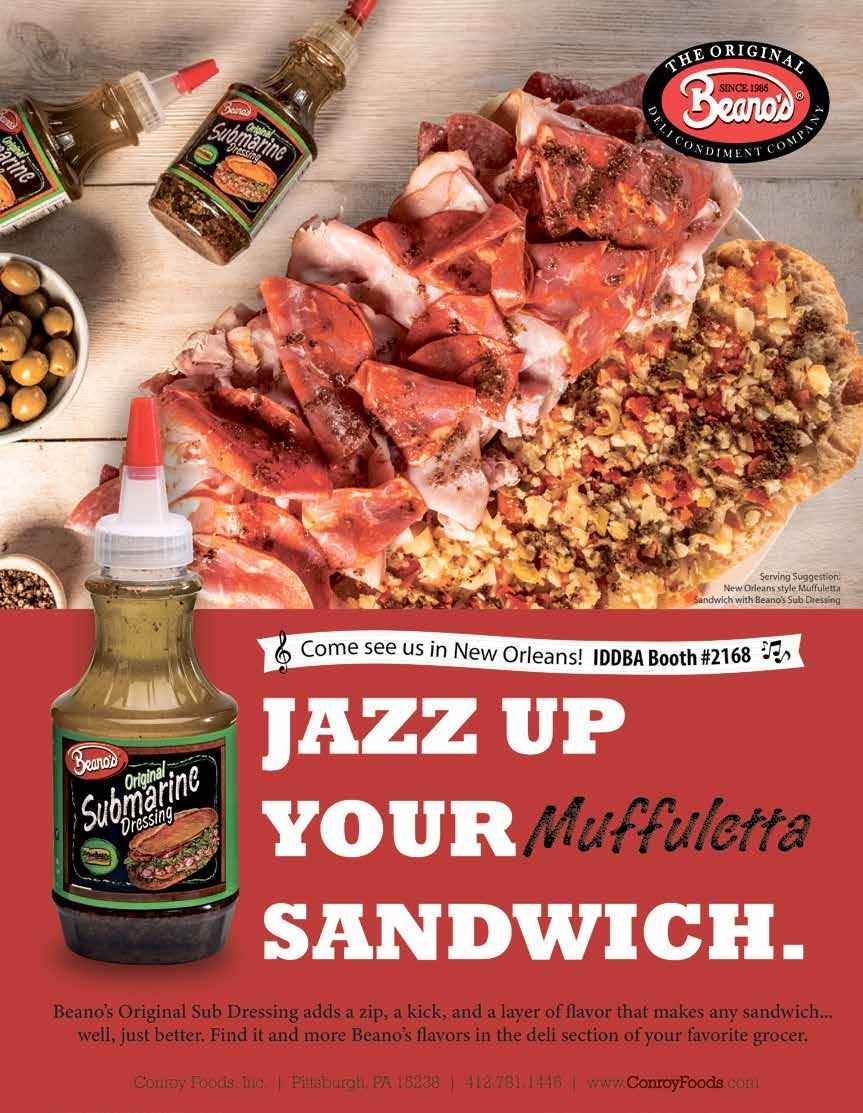

BY CAROL M. BAREUTHER, RD
The best sub sandwich in America in 2018 didn’t originate in a restaurant, from a celebrity chef, or even as a homemade recipe. It came from a supermarket’s deli department. Thrillist, a popular travel, food, and lifestyle website, bestowed this title on Publix Super Markets’ Subs, nicknamed “Pub Subs.”
Since then, other media have sung the praises of these meal-sized hand-helds. Last year, Sporked, a food review and ranking website, gave Publix’s Deli Ultimate Pub Sub — ham, turkey breast, roast beef, cheese and veggies — a 10 out of 10 “Spork” rating.
“Customers today increasingly value their time, are looking for ways to save time, and reducing the time spent preparing meals is one easy solution,” says Hannah Herring, media relations manager for the Lakeland, FL-headquartered chain with 1,400-plusstores in eight southeastern states. “Our signature chicken tender sub is by far our most popular. We have many renditions of this sub, but they all start with our in-house
prepared chicken tenders. The second most popular sub would be our Italian sub, which features Tavern Ham, Genoa Salami and Capicola.”
Publix’s subs are an excellent example of how supermarkets can use their deli’s signature sandwich programs to garner widespread positive publicity, get shoppers in-store, and gain greater register rings.
“Consumers are looking for quality and elevated experiences when shopping for deli sandwiches,” says Lori Kocer, marketing director for retail dairy foods at Land O’Lakes, Inc., in Arden Hills, MN.
Chicken and club are the most popular sandwiches on menus, according to Datassential’s Sandwich Inspiration Report, published in March 2024 by the Chicago, IL-headquartered food and beverage intelligence platform.
According to Liz Jones, senior product manager for packaging maker, Novolex, in
Hartsville, SC, customers continue to crave healthier choices throughout the supermarket, including in the deli. “There’s a growing appetite for sandwiches made with lean meats, nutrient-rich breads, and premium ingredients with fewer additives.”
The fastest-growing sandwich term on menus is “plant-based,” followed by Beyond Meat, plant-based burger, and Impossible Foods, according to the March 2024 Datassential report.
Flavor continues as a powerful purchase driver, says Sean Flynn, director of sales for Niman Ranch, in Westminster, CO. “Taking a page from our friends at Marczyk Fine Foods, their El Bocadillo sandwich is a high-flavor, elevated offering; it includes a lovely portion of our prosciutto, six-month aged Manchego, Spanish olive oil, sherry vinegar, and arugula on a baguette. Another delicious on-trend option is their Parisian, made with our smoked ham, brie, and just the right amount of butter on a baguette.”
Marczyk Fine Foods is a two-store
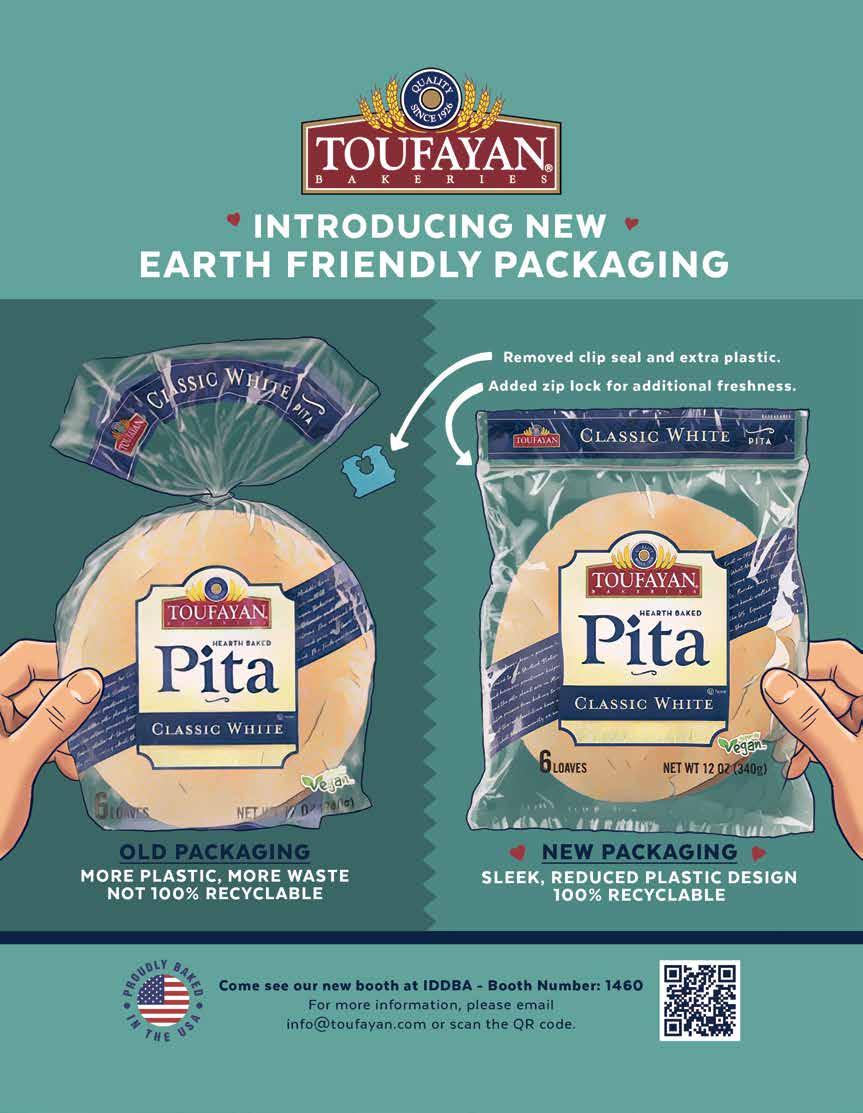
supermarket retail chain based in Denver, CO.
Regional spicy flavors, like Nashville hot, and global inspiration, including chili flakes and halal, are fast-growing, according to Claire Conaghan, trendologist and author of Datassential’s Sandwich Inspiration Report. “These flavors lean into sandwich megatrends, including Middle Eastern, plant-forward, Asian-inspired, Latin influence and U.S. regional.”
Layers of filling, most often meats, cheeses, veggies, and condiments, tucked into bread is the very definition of a sandwich.
Some of the latest deli meat introductions embrace the global flavor trend. For instance, Jennie-O, a turkey products brand and subsidiary of the Hormel Foods Corporation, in Willmar, MN, introduced its Lemon Garlic Turkey this spring.
“For a traditional approach, this product works well in classic limited-time-offer (LTO) sandwiches. For a more modern twist, it can be featured in a pita sandwich with hummus or toum (Lebanese garlic sauce), tomatoes, cucumber, and feta, or as an Italian slider with pesto and provolone,” says Shelly Venenga, senior brand manager.
One of the top deli sandwich cheeses is American. This is especially true in the Northeast, where American cheese is frequently used in sandwiches, according to Land O Lakes’ Kocer. “There are classic sandwiches, too, like ham and Swiss or turkey club with cheddar, that appeal to grab-and-go consumers on a budget.”
As for condiments, Conroy Foods, based in Pittsburgh, PA, has introduced its new Beano’s brand, Nashville Hot Sandwich Sauce. Crafted with honey and cayenne peppers and packaged in a plastic squeeze bottle, it’s ideal for creating a Nashville Hot Chicken Sandwich in-store or cross-merchandised with other ingredients for customers to make at home.
Bread is ultimately what makes a sandwich a sandwich. In February, Publix Super Markets introduced a soft white bread sub roll to its lineup of bread options. This newest addition is baked fresh, from scratch, in-store year-round.
“Eighty percent of consumers say quality bread is the key to creating a fantastic sandwich with freshness, taste/ flavor being among the most influential
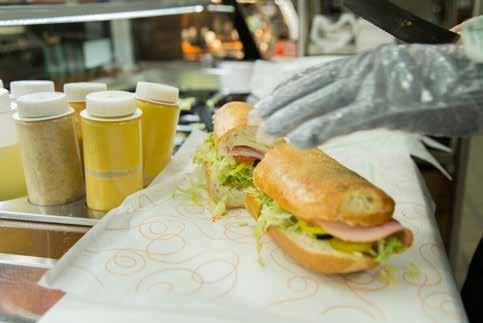
product attributes for purchasing,” says Dave Gonnella, vice president of sales at the Gonnella Baking Company, in Aurora, IL, which offers both frozen dough and thawand-sell breads.
Pretzel buns, most popularly used for signature burgers and elevated chicken sandwiches, experienced a 50%-plus growth over the past four years, according to Kerry Pretzel Insights, Circana Supply Track 2024, as shared by Gonnella.
This source also showed that brioche has had over 20% menu growth over the past four years, with sustained growth of nearly 20% through 2028, driven by serving as the dominant premium sandwich carrier for all meal occasions.
“Our Brioche Pretzel Rolls, launched last year, offer a perfect solution for delivering sandwich inspiration. The rolls blend the light sweetness of our brioche with the saltiness of a pretzel with added crunch thanks to the sesame seeds on top,” says Jake Huber, the Cincinnati, OH-based U.S. sales director for the St Pierre Groupe, a U.K.-based baker and subsidiary of Mexico’s Grupo Bimbo.
Interest in Mediterranean, Latin, and Asian-inspired sandwiches continues to grow.
Gonnella’s new, par-baked quarter sheet focaccia allows deli operators to elevate experiences and differentiate from at-home sandwich occasions. The focaccia can be topped with on-trend spices, herbs, oils, sauces or cheeses, then baked in-store and sliced for specialty sandwiches, thus delivering unique, crave-worthy deli options with no artificial ingredients.
“Our range of pitas, wraps, bagels, and specialty breads meets this demand as versatile globally-inspired sandwich carriers,” says Karen Toufayan, vice president of marketing for Toufayan Bakeries, in Ridgefield,
NJ. “We offer gluten-free wraps and a keto line to provide inclusive options.”
The baker’s newest product is lavash, which is excellent for flatbread sandwiches, creative wraps, or pinwheels. It is a trendy alternative to wraps that make eye-catching grab-and-go selections.
Innovation should focus on grab-and-go, hot, premium, and unique sandwiches, according to Datassential’s Sandwiches Keynote, published in March 2023.
“Our grab-and-go section offers convenience and quality, or customers can enjoy the ability to customize with our made-toorder subs. For those who want the best of both worlds, we offer in-store pickup options that allow customers to customize a fresh-made product without visiting the deli sub line,” says Publix Super Markets’ Herring.
Make sure shoppers can see the ingredients and layers in pre-made sandwiches, adds Niman Ranch’s Flynn. “Cut the sandwich crossways and put the halves side by side. This is more appetizing than looking at bread with hidden ingredients, and ensures shoppers are excited about the quantity and freshness of their selection.”
Dubl View ToGo! Deli Bags from Novolex are the company’s most popular deli sandwich package. There are eight sizes, a polypropylene window for cold applications, and three dimensions, with a PET window for hot.
“Consumers buy with their eyes,” says Jones. “This high-performance deli sandwich package highlights fresh homemade products, promotes brand image, and drives sales by showing off the sandwiches inside. The bags are fully lined with anti-fog film that provides superior visibility.”
The company’s newest sandwich packaging is its PowerPrep wraps and bags. Created for grab-and-go applications, this multi-layered, laminated, and insulated wrap allows freshly made food to be wrapped or bagged, frozen, reheated, and held under heat at point-of-sale and maintain good quality.
Made-to-order is one of the most popular deli sandwich programs today, according to Toufayan Bakeries’ Toufayan. “A fresh, made-to-order sandwich program allows customers to customize their sandwiches with preferred ingredients, making it a more premium and personalized experience. This can lead to higher margins and increased customer satisfaction. However, it requires more labor, skilled staff, and efficient operations to prevent long wait times. Made-to-order sandwiches work best in high-traffic delis where customer demand supports the additional labor costs. Overall, retailers benefit most when they offer both programs in-store.”
The easiest, yet still successful, deli sandwich program is simply cross-merchandising ingredients in one display.
“Keep all sandwich components — meats, cheeses, toppings and breads — together in the deli space for easy grab-and-go convenience,” says Hormel’s Venenga. “A more modern approach is expanding visibility by promoting deli sandwiches in other key store areas, such as the bread and condiment aisles, to encourage cross-purchasing.
According to Herring, Publix Super Markets offers a sub combo option with any custom sub or wrap. “Customers receive $1 off the price of the sandwich, with the choice of chips or soup and a drink.”
Introducing rotational or seasonal sandwiches can keep the section fresh and exciting for customers, encouraging them to explore and try new items.
“One great way to build excitement is by letting the deli team create a favorite sandwich and promote it as the ‘Pick of the Week,’” says Hormel’s Venenga.
Try interactive sampling stations, international-themed sandwich days, and seasonal promotions, recommends Toufayan. “Showcase fresh-made sandwiches with a build-your-own tasting station. Or rotate weekly sandwich features, for example, Mediterranean Monday with Pita Wraps and
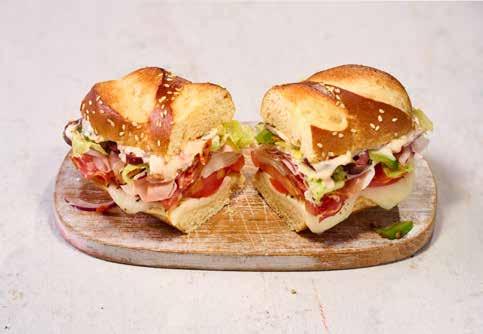
Flatbread Friday with flatbread sandwiches. Or introduce holiday-themed sandwiches or limited-time offerings, like a Pumpkin-Spiced Breakfast Flatbread in the fall.”
Finally, deli sandwich programs should
be expanded to include catering. Publix, for example, provides a boxed meal solution with custom subs and options for side items and beverages that are great for larger group gatherings.
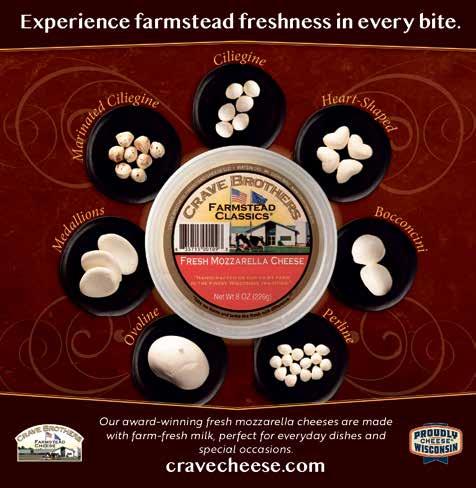
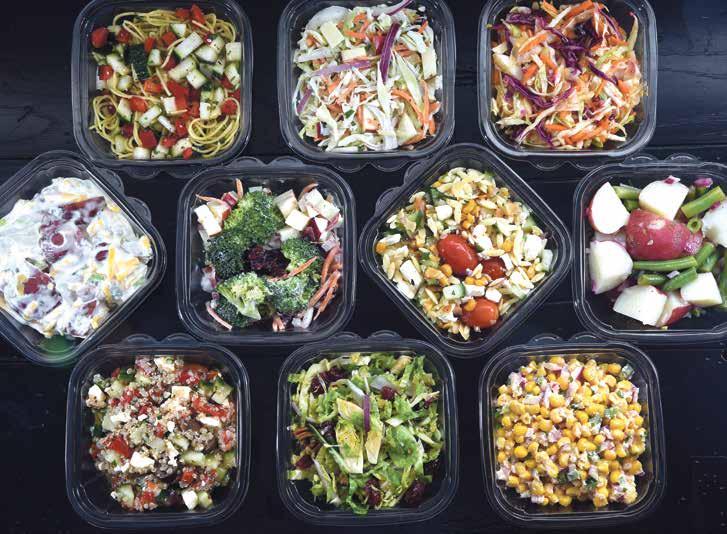
BY KEITH LORIA
Driven by a growing demand for healthier food, time constraints and a desire for convenience, consumers are increasingly turning to salads and side dishes at supermarket delis. These both help balance meals and add a sense of flavor and variety to the run-ofthe-mill dinner plate.
The latest data from the International Dairy Deli Bakery Association (IDDBA), released in April 2025, revealed that salads have seen a nice uptick at the supermarket over the last year, registering $5.1 billion over the last 12 months, an increase of 4% in sales and 5.4% in units year-over-year.
Meanwhile, side dishes have also seen an increase, bringing in $2.2 billion in sales, a rise of 4.6% in dollars and 3.9% in units sold.
Not surprisingly, many retailers are
expanding their selections, offering an array of vibrant salads and innovative side dishes that cater to diverse tastes and lifestyles.
“Consumers continue to seek convenience and look to grocery store delis for affordable, time-saving whole meal solutions that don’t lack in quality,” says Megan Moore Torres, brand manager, deli salads and sides for Beaverton, OR-based Reser’s Fine Foods. “Our offerings complement this strategy, from packaged salads and sides for meal deals to bulk offerings ideal for retailers’ on-premises meals.”
In 2025, Reser’s Fine Foods is celebrating its 75th anniversary of offering prepared salads and side dishes in grocery store delis, such as its potato and macaroni salads, mashed potatoes and macaroni & cheese, and continue to innovate in the segment.
“To keep things fresh, offer consumers variety and meet evolving tastes, we release new, trend-forward items, like our new Spicy Pickle Potato Salad or Chili Crisp Pasta Salad,” says Torres.
Jonathan Stack, president of Fresh Creative Cuisine, Baltimore, MD, notes the company is a big believer in championing the “fresh” aspect of the name, with its products typically having a seven- to nine-day shelf life.
“We are traditionally just using cold chain management and high-quality artisan-type of ingredients,” he says. “We concentrate on the way we product the product, and 90% of our plant and all of the production areas are a 34- to 36-degree production room. That’s part of our methodology where the product stays under constant cold-chain management throughout the entire process.”
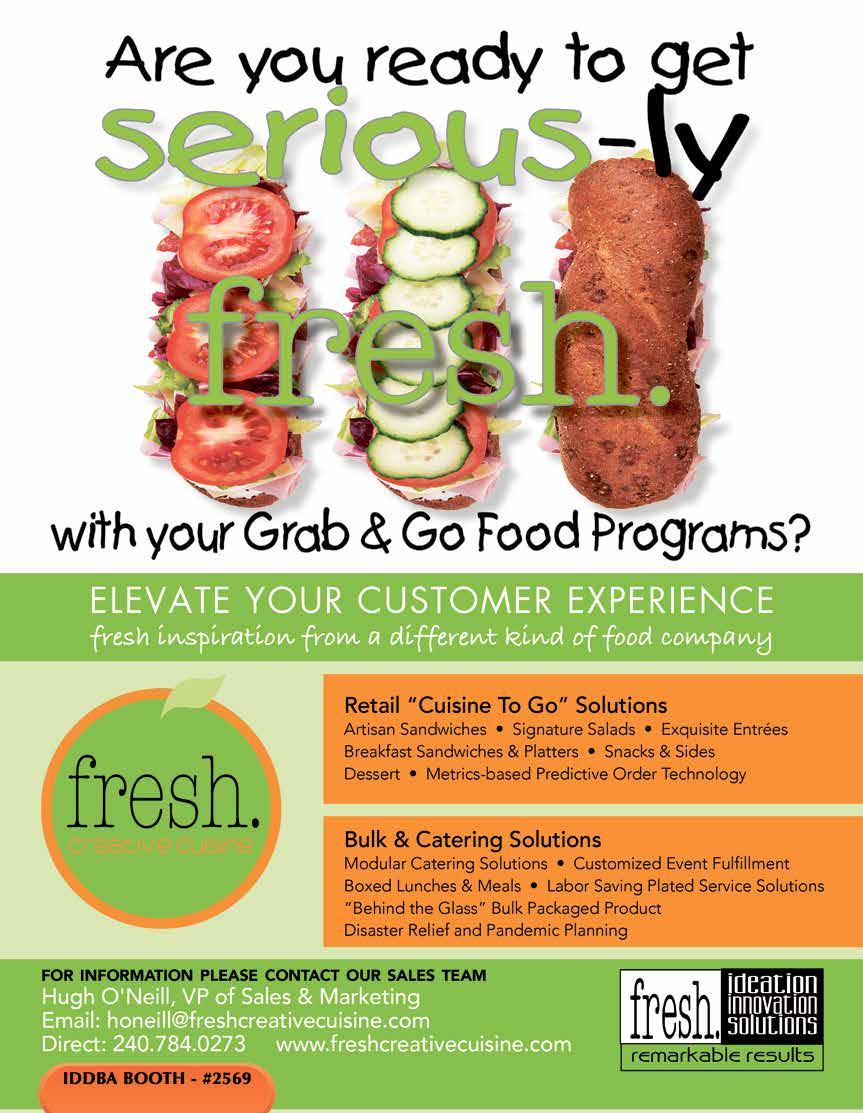
Fresh Creative Cuisine produces everything from core artisan sandwiches to heat-and-eat entrees, and alternate items, including snacks and sides, fresh-cut fruit and more.
Hugh O’Neill, vice president of sales and marketing for Fresh Creative Cuisine, notes there are a lot of different types of customers who are buying their products, with everyone from Gen Xers to Millennials to Boomers and everyone in between.
“There are some things that are similar throughout the clientele, and one is that people are looking for and demanding fresh products,” he says. “We’ve seen recently there has been some pushback on MAP-packaged items, things with extended shelf life. People are looking for fresh, and they want to see natural products where they can.”
Serenity Maxwell, foodservice brand manager for Marlborough, MA-based Ken’s Foods, a retail grocery producer of salad dressings, sauces and marinades that manufactures more than 400 varieties, including Sweet Baby Ray’s barbeque sauce, notes supermarkets are realizing the importance of dressings and sauces.
“Bulk items are used in premade items, like coleslaws, salads and sandwiches, while portion control packs are ideal for graband-go meals,” she says. “Our sauces and dressings include cocktail sauce, mayonnaise, honey mustard, tartar sauce, sweet and sour sauce and coleslaw dressing.”
Some of the big industry trends Maxwell is noticing include an increasing interest in spicy, global and ethnic/world flavors.
“Customization, take-out and comfort foods with a twist also remain popular,” she says. “Swicy also looks like a trend that’s here to stay, mixing sweet and spicy flavors, like mango habanero and our newest spicy peach wing sauce.”
Regardless of the category — wraps, sandwiches, salads, etc., Stack notes Fresh Creative Cuisine has seen people continue to respond to bold flavors, so it has made an effort to integrate those in its side dishes and salads.
“We see high-level requests for ethnic and global flavor profiles,” he says. “People see things on the Food Network and in the media, and people have become much more aware of the different global flavors available and want to try them.”
For instance, there have been recent influences of Caribbean jerk seasonings, Indian

influences and Mediterranean taste profiles.
“Our executive chef and culinary team are constantly designing new products based on those things that are happening out in the market,” says Stack. “A few weeks ago, we started testing, not just in our salad profile but in our sandwich profile, changing some of the standard cheeses and looking at things like tomato-olive cheese and chipotle-jack and things to provide that bold flavor. You may have a standard salad, but that new cheese profile adds a whole different aspect to that salad.”
Fresh Creative Cuisine is offering a number of different things that incorporate lighter fare in its salads. Among recent offerings are citrus slaws, a broccoli apple crunch salad and loaded baked potato.
“We’re taking inspiration from picnic days of old and bringing them into the retail format and have had great response,” says Stack.
Carl H. Cappelli, senior vice president of sales and business development for Don’s Prepared Foods, Schwenksville, PA, notes the company works hard to provide cool, unique and globally inspired side dishes.
“Don’s offers clean and restaurant-quality sides that inspire home-cooked meals,” he says.
The trends he is keeping an eye on concern value and flavor, driven by economic factors as consumers are seeking more meal solutions at retail, and side dishes are a big part of completing the meal.
“The staples in retail deli will always be
potato, macaroni, and coleslaw salads, and while Don’s offers many varieties of those commodity salads, it is the unique items consumers seek out,” says Cappelli. “Don’s will always provide new and innovative flavors to drive retail deli sales. For instance, in April, Don’s will launch three new salads with a Mediterranean flavor.”
This year, Reser’s has two new innovative meal solution offerings — Potato Rosettes, creamy mashed potatoes piped into swirls, then baked to a golden brown, and Twice Baked Potatoes.
“From a flavor perspective, we see consumers interested in bold, tangy and spicy flavor profiles within familiar formats,” says Torres. “We’ve recently introduced a Spicy Pickle Potato Salad and Salt & Vinegar Potato Salad, as well as a Chili Crisp Pasta Salad, featuring the on-trend Chinese condiment that’s captivating consumers everywhere.”
Another big trend of late has been a significant rise in the availability of vegan, gluten-free and healthier salads and side dishes.
“Health and weight loss drugs are causing a slight shift toward increased perimeter shopping, and dressings and sauces are a great way to add and customize the flavor of vegetables and other healthy foods,” says Ken’s Maxwell. “We offer gluten-free products and have a clean-label line of dressings for the health-conscious (Ken’s Essentials).
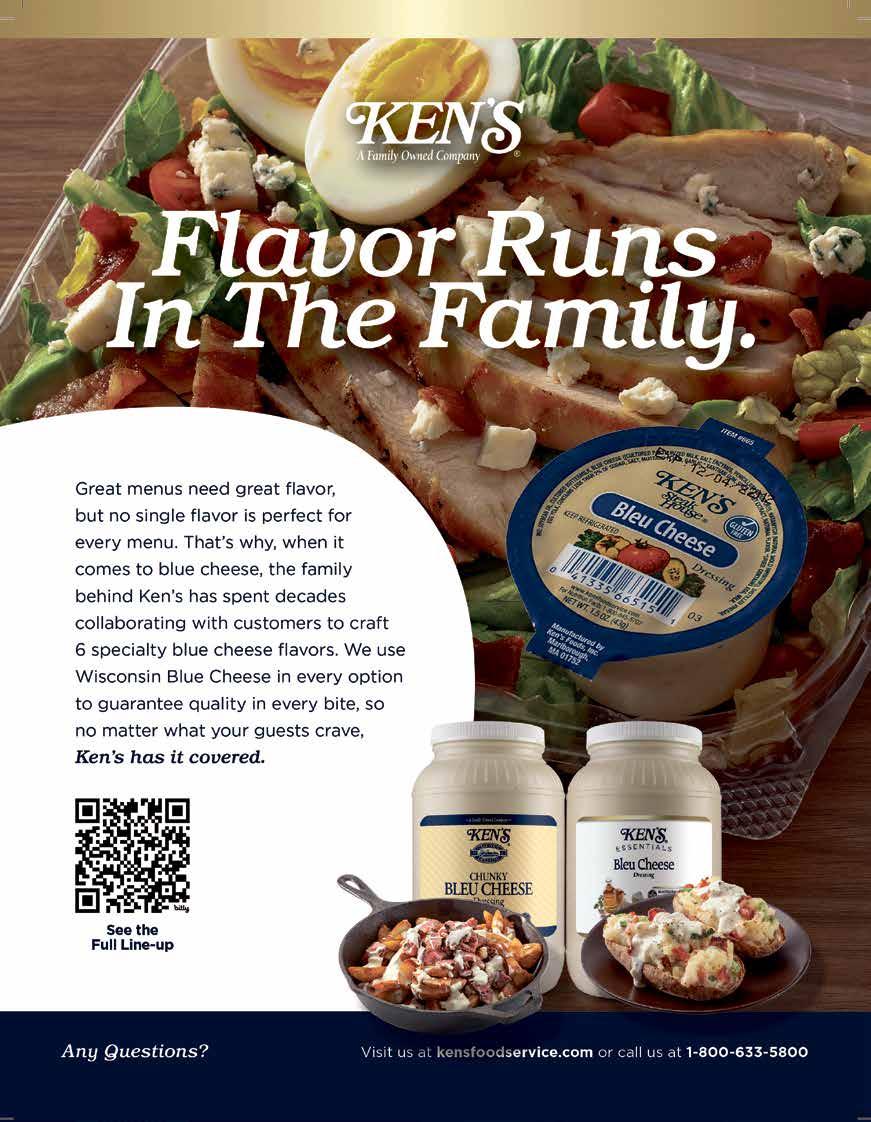

We regularly receive vegan/plant-based requests, but there’s not a lot of volume to back them up.”
Fresh Creative Cuisine’s O’Neill says that in addition to those looking for plant-based items, the company focuses on some other dietary restriction options, whether it be vegetarian, vegan, nut-free or dairy-free.
Cappelli has seen a rise in the demand for vegetarian and vegan options, and offers a wide variety of grains and sides meeting these criteria.
“Consumers love the items, even if not vegan, because they enjoy healthier items,” says Cappelli.
There’s no better way to attract consumers to the deli department and the sides and salads they sell than to show the items, says Cappelli.
“Retail deli departments that show the meal or items plated will find success,” he says. “This shows consumers what they can do at home. Just like the expression, ‘A picture is worth a thousand words,’ showing the meal solution will help drive retail deli sales.”
When it comes to merchandising, Reser’s continues to see growing value within its retail partners’ retail media networks.
“As retailers develop their customer marketing opportunities and share insights, it allows us to offer more tailored, effective messaging to reach our consumers, then learn and optimize for future programs,” says Reser’s Torres. “For example, if a retailer
offers split creative on in-store signage or email campaigns, we can test multiple messages for effectiveness among retailer’s audience and continually evolve our conversation with the consumer.”
Stack says trade shows continue to be a main marketing tool for Fresh Creative Cuisine, as most of its marketing is aimed at its clients.
“We find our networks of culinary teams and folks that we work with tends to be a strong provider for new leads,” he says. “The marketing end on the retail side, we are partnering with a main meat or cheese or protein player, and we do private label products, and a lot of our main opportunities may come from one of our other ingredient partners. We are constantly working with our category management teams and suggesting a rotation of items.”
Many delis are offering meal bundling programs, with the IDDBA seeing a big increase in these since the pandemic.
Torres notes that salads should 100% be part of any successful meal bundling program.
“We’ve seen success in pairing our deli salads and sides in meal deal programs,” she says. “We consider them all to be options that pair perfectly with a main protein, allowing consumers to decide if they’d prefer a cold side, like potato salad, or a hot side like macaroni and cheese.”
For deli managers looking to do even
“The staples in retail deli will always be potato, macaroni, and coleslaw salads, and while Don’s offers many varieties of those commodity salads, it is the unique items consumers seek out.”
Carl
H. Cappelli, Don’s Prepared Foods, Schwenksville, PA
more with their salad and side dish offerings, it’s important to be savvy with the look of the entire department.
“Keep focusing on the deli’s strengths, offering freshness, convenience and value, and remind shoppers of those strengths with consistent messaging,” says Torres.
O’Neill says many supermarkets are still struggling with in-store labor, and the ability to fulfill and execute on an artisan level in-store becomes a challenge. But because the company is a private label manufacturer and also a client spec manufacturer, it can create a signature item or line of products for a particular client that they will produce only for them.
“What we find day in and day out or year to year is where our clients can excel is on the service level,” he says. “They can take the in-store labor that they do have, maintaining optimization of inventory. Keeping the grab-and-go cases full, they do extremely well when they look market fresh and market full.”
As the demand for salads and side dishes continues to evolve, supermarket delis are rising to the challenge, infusing their offerings with innovation and flavor to cater to an increasingly discerning customer base.
With a focus on fresh ingredients, global taste profiles and healthier options, these retailers are not just meeting preferences — they are shaping the way we think about meal preparation and convenience, transforming the grocery store deli into a go-to destination for flavorful, nutritious options that fit the fast-paced lifestyles of today’s consumers. DB

BY CAROL M. BAREUTHER, RD
Walk into the deli at a Publix Super Market and find that soup du jour awaits. There’s everything from comfort favorites, like chicken noodle and New England clam chowder, to cooler flavors, like turkey sausage, kale and quinoa and Mexican-style street corn soups.
Many of the 1,400 southeast locations of this Lakeland, FL-headquartered chain have a hot soup bar. There are four ready-to-eat selections daily, with 12-, 16- or 32-ounce cup sizes to satisfy singles or the family circle, with gratis go-withs like saltines.
A menu at the top of the display lists the day’s soups. Steps away in a refrigerated multideck grab-and-go case are nationally branded soups ready-to-heat and eat. This case also holds pre-made sandwiches, wraps and salads. Near the retailer’s hot soup bar, customers can also order made-to-order subs, often as a meal deal combo.
Publix is one of hundreds of retailers nationwide putting stock in its soup program, creating a one-stop shop destination for a quick meal that rivals quick and casual restaurants.
“Fresh soups in the deli are a magnet for customers as they are a satisfying graband-go item that offers a quick meal solution without compromising on quality or flavor,” says Joe Jolly, chief executive officer of the Plenus Group, Inc. (PGI), in Lowell, MA, which sells its soups under the Boston Chowda and Herban Fresh brands.
Moreover, 75% of shoppers buy groceries where they purchase hot food, according to Bob Sewall, chief customer officer and executive vice president of sales and marketing for Blount Fine Foods in Fall River, MA. “Consider that younger customers are buying more soup today, and this customer shops two to three times per week.”
Soup in mankind’s diet is likely as old as the history of cooking. The act of boiling bits and pieces of meat, grains, beans, and veggies

in a big kettle is common in nearly every culture. For starters, there’s New England clam chowder, Cuban black bean, Italian minestrone, French onion, Russian borscht, Spanish gazpacho, and Vietnamese pho, to name a few.
Soups and chili represent almost $1 billion in sales and nearly 4% of deli-prepared food and meal sales in the supermarket deli.
The dollar change trajectory in sales is up 5.4% from a year ago and 12.6% and 37.4% versus two and three years prior, respectively, according to Circana data for the 12 months ending Oct. 6, 2024, as published in the International Dairy-Deli-Bakery Association’s What’s in Store 2025. Only 20% of households purchase deli soups and chili, showing ample room for growth.
“Soup consumption peaks from mid-September through March, making it essential for retailers to align their sets and assortments with seasonal demand throughout the year,” says Mike Seeger, vice president of Walmart and Club at Kettle Cuisine, in
MA, with Kettle Cuisine and Soup Supreme brands.
To do this, choose a captivating flavor assortment; consider a hot, cold, or hot and cold soup program; and create a deli soup destination.
Comfort, trendy global flavors, and healthful are all great to promote when it comes to soups, according to Mary Shepard, director of sales and partner in Fortun Foods, Inc., in Kirkland, WA, which sells under the Stockpot Soups brand. “But it all comes down to quality, whether or not a customer is one and done or someone who comes back for repeat purchases.”
On the comfort front, PGI’s best-selling soups remain its New England Clam Chowder and Rockport Lobster Bisque, which speaks to the company’s roots as the Boston Chowda Soup line manufacturer.
“These are soups that are not normally made at home and deliver a
restaurant-quality experience,” says Jolly.
PGI has a significant private label business, developing new soups to suit a retailer’s customer demographic and regional food preferences.
“For a retailer with a large Italian American customer base, we’ve created a White Bean and Escarole Soup and a Lasagna Soup that has done very well,” says Jolly. “For a retailer in New York City, Manhattan Clam Chowder and Chicken & Matzo Ball Soup are strong sellers.”
Last September, Nooish, a Chicago, IL-based company specializing in kosher, on-the-go food, introduced the first Instant Matzo Ball Soup.
“Similar to instant ramen, you add water, microwave, and voila, you have a fresh bowl of vegetarian, kosher matzo ball soup made with clean ingredients. It satisfies the trends of convenience, easy meal making, comfort food, and an interest in global flavors. Our product is certified CRC kosher pareve,” says Sarah Nathan, founder.
Tried-and-true favorites like Broccoli Cheddar, Loaded Baked Potato, and Chicken Tortilla are top sellers for Kettle Cuisine.
“There’s growing demand for comfort foods with modern twists,” says Seeger.
For younger consumers, global flavors, specifically Latin and Asian, are familiar and comforting, according to Mike Kostyo, vice president of Menu Matters, an Arlington, VT-based menu consulting firm focused on the food industry. “A Gen Z or Millennial consumer grew up eating premium ramen options, even knowing the difference between a tonkatsu and shoyu ramen. They expect to see a tortilla soup available. These options are the norm.”
Thai Shrimp Soup, made with dairy-free coconut milk, offering an alternative to a dairy-heavy bisque, is new from Blount Fine Foods’ Clam Shack line of soups. The company, whose brands include Blount Family

Kitchens and Panera, uses authentic masa in some of its products, particularly Cheesy Chicken Enchilada Soup.
“At some of the innovative global restaurants we’re tracking, you see far more Middle Eastern options, like bright, lemony lentil, squash, or bean soups. Next-level Asian options like Malaysian laksa, Thai curry soups like khao soi, and Filipino sinigang are showing up at innovative restaurants, so they should be on a deli operator’s radar,” says Kostyo.
Consumers are also driving soup innovation in the direction of “good-for-you” health-conscious soups with clean ingredients and plant-based options, says Kettle Cuisine’s Seeger. “Our newer offerings include a healthier take on the classic canned alphabet soup, called Alphabet Pasta with Beef Meatballs, and a French onion soup designed to be finished at home with gruyere and crostini for a restaurant-style experience.”
The best way to introduce new soup items, says PGI’s Jolly, “is a compelling sale offer along with a spot in the retailer’s weekly circular. In-store merchandising, like shelf tags, danglers, and counter signs, help greatly with visibility.”
Overall, in selecting the soup flavor lineup for the deli, the 80/20 rule still applies.
“The biggest sales we find are still the comfort soups and what consumers are familiar with. The interesting new flavors will sell, but consumers will still return to what is familiar,” says Fortun Foods’ Shepard.
Both hot and cold soups are popular, each serving different needs.
“Hot soups drive impulse purchases and immediate consumption, while cold, readyto-heat options offer convenience for later meals. To succeed with both, deli operators should ensure clear signage, consistent quality and strategic placement — hot soups near lunch traffic and cold soups in grab-and-go cases with cross-merchandising to encourage meal bundling,” says Seeger.
Running a successful hot soup program takes dedication from the retailer to maintain their hot bar properly, ensuring the product is kept filled and at the proper temperature to avoid the soup degrading over the selling period.
“A great synergy is when retailers have the cold soup (tubs) from the same company that supplies the hot soup program,” says Shepard.
These global options also speak to deeper consumer needs. They want to travel, getaway, and experience new places, and a global flavor or soup can be that little escape in the day.”
Mike Kostyo, Menu Matters, Arlington, VT
Two big benefits of building a soup destination in the deli are repeat purchases and bigger basket rings.
“Having a dedicated space for fresh soups drives demand and builds shopper loyalty. When customers know exactly where to find them, soup becomes a routine purchase — unlike when it’s mixed into the broader deli set,” says Seeger.
PGI’s Jolly recommends creating “a wall of soup.”
“Retailers who commit to carrying a wide variety of soups experience the best sell-through. Having such a display makes soup a focus in the deli and draws people to the department,” he says.
Cross-merchandise complementary items, like salad kits, bread, or desserts in or adjacent to this soup wall, adds Kettle Cuisine’s Seeger. “Bundle soups with beverages or snacks to create meal deals and use in-store displays to suggest pairings. Offering convenient, complete meal solutions encourages shoppers to add more items to their baskets.”
Finally, rival restaurants by treating a soup bar as a meal station rather than a side dish, adds Fortun Foods’ Shepard. “Kick it up a notch with garnishing for customers to top off their soup. Give them control and tools to make a masterpiece of what they desire. Have that French bread handy to grab-and-go. Add cheese or crackers, croutons, or herbs. Build a soup bar like this, and they will come.” DB


BY CAROL M. BAREUTHER, RD
Some are almost the size of a quarter, others nearly a nickel, while most are of dime-sized dimensions. It’s the “eyes,” or holes, which unite several varieties of yellow, medium-hard cheese known generally as Swiss in North America. These holes, or “eyes,” aren’t the artistic work of a cheesemaker, but instead are caused by bacteria that produce carbon dioxide during the process of making Swiss cheese.
Emmentaler is often synonymous with Swiss cheese, and indeed, the U.S. Department of Agriculture (USDA) uses the terms Swiss cheese and Emmentaler interchangeably regarding grades and standards. However, deli operators should be sure to stock and let shoppers know there’s much more.
“We describe Swiss cheese as a style and less associated with the Country of Origin. When the cheese is truly from Switzerland, we make it known, i.e., Swiss Emmentaler or Switzerland Swiss. Otherwise, the style of Swiss cheese can be made domestically, or even in other European countries, like Jarlsberg,” says Bryan Bland, specialty cheese category manager for Cincinnati, OH-headquartered The Kroger Co., which includes the over 1,100 Murray’s Cheese shops in the retailer’s supermarkets.
“True Emmentaler AOP is a handcrafted product made only in specific regions of Switzerland under strict guidelines,” says Daniel Schnyder, director of imports and key accounts for Stoughton, WI-headquartered Emmi Roth USA, which both makes and imports top specialty cheeses, like Swiss and is a subsidiary of the Switzerland-based Emmi Group. “For example, the cows providing the milk must live within 12 miles of the cheesemaker and eat only fresh grass and hay.
Emmentaler doesn’t separate when heated, making it ideal as a melted cheese.
European-made Emmentaler may use animal rennet; thus, it is not vegetarian.”
Walpole adds that aged Swiss, typically aged for three to six months, has a sharper flavor. The sharpness increases the longer the cheese ages. The company also produces a Lacey Baby Swiss, which is aged 30 days, has a creamier texture and the mildest flavor of a Swiss style of cheese with just a touch of nuttiness.
Le Gruyère AOP, with small “eyes” compared to Emmentaler, is the best-selling Swiss-type cheese at Murray’s Kroger-located cheese shops, says Bland.

Popular uses include Reuben and Cubano sandwiches, rolled up with ham in chicken cordon bleu, grated over pasta and atop gratins, and as the foundation for fondue.
This Swiss cheese, also called Emmental and Emmenthal, is a mild, nutty-flavored cheese aged at least 60 days.
Emmentaler, often referred to as the “original Swiss cheese or the king of cheese,” originated in the Emme Valley of Switzerland in the 13th century. Its name comes from this picturesque region, known for its rolling hills, traditional farmhouses, and strong cheesemaking tradition.
“It’s high in protein, low in sodium and lactose-free,” says Mike Walpole, national sales manager for Brewster Cheese, the Brewster, OH-based largest manufacturer of Swiss cheese in the U.S. “U.S.-manufactured Emmentaler may be suitable for lacto-vegetarian diets if the enzyme, i.e., rennet, doesn’t come from animals. Traditional
“This cheese appears on nearly every shopping list around key entertaining holidays. In some of our more mountainous regions, we see higher demand for Gruyere and other similar cheeses throughout the ski season, with an increase in the number of European tourists.
“We focus on selling Gruyere cut fresh from the wheel in large pieces since it is so versatile in cooking and snacking. We also sell shredded Gruyere for customers seeking more convenience in their recipe-building.”
Sid’s Bahl Baby Swiss, a rich, creamy take on Swiss-style cheese with smaller “eyes” and a smooth, buttery flavor, is made by the Carr Valley Cheese Company in La Valle, WI.
“We also make Maustoner, a unique Gouda-Swiss blend that combines the nutty, caramel-like notes of Gouda with the mild, creamy texture of Swiss, creating a cheese that is both familiar and uniquely satisfying,”

“Our Swiss cheese customer is typically very recipe-driven and focused on cooking, so providing the various uses for these cheeses is always of high interest.”
says Elle Fearing, national sales and marketing representative for Carr Valley.
The top-selling Swiss cheese for Heartisan Foods is its Smoked Swiss Cheese.
“Our Smoked Swiss cheese is hickory-smoked in Wisconsin. The flavor is creamy, nutty, and rich with hints of butter and walnuts,” says Sarah Jackson, director of commercial sales and marketing
operations for the Barron, WI-based cheesemaker, which markets its products under the Red Apple Cheese, Cheese Brothers and Naturally Good Kosher brands.
Demand for Gruyere and Emmentaler is primarily in unsliced larger pieces at Murray’s Kroger-based cheese shop. “This is so the customer has more options at home, whether they want to slice or shred it themselves or just eat as a snack or on a composed cheeseboard,” says Bland.
Continued growing interest in charcuterie has led to double-digit growth in all bricks, bars, and rounds of cheese at Heartisan Foods, according to Jackson.
Consumer demand for pre-sliced cheese continues to grow due to convenience. However, there’s still a strong audience for deli-cut blocks, which allow for customization and freshness, says Carr Valley’s Fearing.
“Supermarkets can cater to both by offering pre-sliced options for grab-and-go shoppers, while maintaining a selection of premium, aged Swiss for slicing at the counter. Encouraging customers to try
freshly sliced cheese in the deli can elevate their experience and appreciation.”
SEVERAL WAYS TO SELL MORE
Display and merchandising techniques, such as sampling, recipes, and education, can help grow Swiss cheese sales in retail.
In Murray’s Kroger-located cheese shops, says Bland, “We display cheeses more closely aligned to similar uses rather than origin. This strategy ends up grouping several Swiss and Swiss-style cheeses so the customer can choose what works best for their needs without searching too far for options. We like to create large footprints of Gruyere in the case, as this clearly communicates to our customers that they’ve arrived at the Gruyere.”
Cross-merchandising is also effective. For example, pair Emmentaler with Gruyere for fondue kits, including bread, vegetables and cornichons.
“Our Swiss cheese customer is typically very recipe-driven and focused on cooking, so providing the various uses for these cheeses is always of high interest,” says Kroger’s Bland. “The origin story and Alpine connection also play a big role in understanding the difference in Swiss cheeses versus other Swiss-style cheeses.” DB
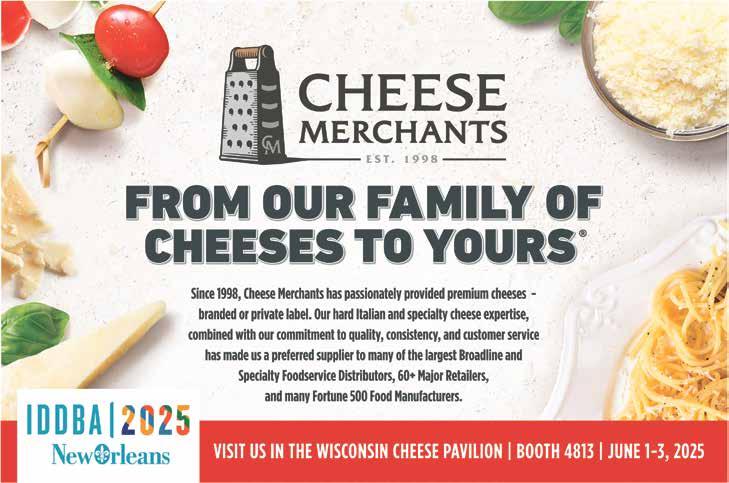
The Mediterranean segment continues expanding in delis due to healthful and flavorful options.
BY LISA WHITE
The Mediterranean food segment is in a growth trajectory, and this reveals great opportunity in supermarket delis.
Revenue grew at a compound annual growth rate of 3% to $33.4 billion over the last five years, including a rise of 0.2% in 2024, according to New York-based IBISWorld.
“Mediterranean inspired foods have continued to gain in popularity in the supermarket, with many now considered mainstream, including hummus, feta cheese, and even tabbouleh,” says Monica Belsito, chief marketing officer, Sabra Dipping Co., White Plains, NY.
Not only does this diet feature flavorful and diverse food, but it has long been touted as one of the healthiest diets.
“The Mediterranean diet emphasizes plant-based foods, including whole grains, beans, nuts and extra-virgin olive oil,” says Mike Paribello, senior vice president of marketing and retail sales for Grecian Delight | Kronos, Elk Grove Village, IL. “Popular in regions like Greece, Italy, Spain and Turkey, the traditional diet features a modest amount of lean poultry and plenty of seafood, focusing on overall diet quality, rather than specific nutrients.”
Rich in healthy fats, lean proteins, whole grains and fresh produce, it provides a way to promote overall wellness.
“The growing popularity of Mediterranean foods can be attributed to an increased consumer focus on health-conscious eating, a desire for globally inspired flavors and a rising preference for clean-label products made with high-quality ingredients,” says Aimee Tsakirellis, executive vice president, marketing at Cedar’s Foods, Haverhill, MA.

With today’s consumers seeking globally-inspired flavors, providers of Mediterranean foods are expanding their portfolios.
Sabra’s Falafel Style Hummus has bold flavor combinations of a stacked falafel platter with creamy, Mediterranean-inspired hummus.
Grecian Delight’s new launches include Opaa! Brand ReadyCarved Global Proteins in Old World Chicken Gyro, Pork Al Pastor and Halal Chicken Shawarma varieties.
“These meats come pre-marinated, precooked and flame-broiled,” says Paribello. “Carved off-the-cone, they’re free from MSG and deliver ethnic flavors in minutes — simply heat and serve.”
The Opaa! Brand also offers Individually Wrapped Gyro Sandwiches & Gyro Kits, a Mediterranean Chicken Kit, and an Individually Wrapped Sandwich line.
Also new is Grecian Delight’s Garbanzees Chickpea Bites, which are made from chickpeas and a blend of vegetables, herbs and
seasonings. Each fritter heats in minutes in an air fryer or oven and can be used in a wrap, on a salad or as an appetizer or snack.
Cedar’s Foods provides authentic, traditional flavors, such as Red Pepper Hommus and Cucumber Garlic Tzatziki Dip.
“At the same time, we have embraced innovation, introducing bold new varieties, like Dark Chocolate Hommus and Dark Chocolate Cinnamon Hommus,” says Tsakirellis. “Cedar’s Spicy Pepper Feta Dip and Kalamata Olive Feta Dip showcase how we are experimenting with creamy, tangy and zesty profiles to keep Mediterranean flavors exciting.”
Atlanta, GA’s Yaza Foods offers labneh, a Greek yogurt version that is milk-based, strained with salt and over 2,000 years old.
“It’s very healthy, as labneh is high in protein and probiotics, yet low in fat and calories,” says Yaza Foods founder Karim Khalil. “Labneh is a staple in Lebanese cuisine that can be used in any meal, such as a rice bowl or as a naan or pita marinade.”
Introduced in April 2019, Hummus
Goodness’ hummus lines contain no soybean oil for a clean label and fresh taste.
Founder of the Birmingham, MI-based company, Hannah Awada grew up in a Lebanese household and wanted to create a hummus like her mom used to make.
“We then started adding flavors, like beet, chili flakes, sriracha, roasted garlic and red pepper,” says Awada. “We also offer a pickle-flavored hummus and a taco flavor variety, as the majority of consumers gravitate toward flavors they know.”
According to Ehud Soriano, olive oil consultant and olive oil panel leader, Sindyanna of Galilee, Tel Aviv, Israel, since Mediterranean cuisine is based on simple, natural ingredients, it lends itself to creative and nutritious combinations. “Current trends focus on pairing sweet and savory elements, such as carob, date, grape or fig syrups, as well as chocolate infused with olive oil,” says Soriano. “These innovations challenge the dominance of ultra-processed foods by offering healthier, more nutritious alternatives.”
With so many new developments, there have been several packaging innovations in the Mediterranean food space.
“Sabra’s packaging was groundbreaking when first introduced because it allowed consumers to see the food they were buying, to appreciate the variety of flavors, as well as the visible mound of toppings,” says Belsito. “We also pioneered on-the-go options with our Snackers and continue to expand that line.”
Mediterranean foods are at the forefront of meeting consumer packaging preferences by offering convenient and practical solutions.
“Products are designed to be proportioned and easy to serve, ensuring a hassle-free experience,” says Paribello at Grecian Delight. “Easy-open packaging enhances accessibility, while resealable options help maintain freshness where applicable. Additionally, efforts are made to minimize excessive packaging, aligning with environmentally conscious consumer demands. Many packages also include preparation instructions and recipe suggestions, making it easier for consumers to enjoy Mediterranean cuisine at home.”
Additionally, snacking and grab-and-go options remain on trend as consumers increasingly seek convenient, on-the-go choices.
“Consumers are more aware of hummus and looking for larger sizes,” says Awada

at Hummus Goodness. “We’re also seeing more of a demand for grab-and-go with 2-ounce containers.”
While packaging trends vary, Mediterranean foods offer a wide range of options to suit different needs, ranging from small 0.5L bottles to larger 5L tins of olive oil, as well as various sizes of cheese blocks, fermented or pickled vegetables.
Sindyanna of Galilee emphasizes the social impact of its products, adding an extra layer of value to Mediterranean foods.
“Our Fair Trade-certified products promote messages of peace, unity and solidarity,” says Soriano. “This philosophy is reflected in our olive oil labels, which feature names such as Extra Peaceful, Extra Social and Extra Unified.”
There are several effective strategies to keep Mediterranean foods front and center in the deli.
“Retailers can introduce consumers to hummus by showcasing it with everyday snacking options, like pita chips, pretzels, marinated olives or feta cheese,” says Belsito at Sabra. “We also see retailers successfully highlighting Mediterranean foods in wellness-centric promotions or when spotlighting plant-based eating. Shelf blades, recipe cards and in-store demos can help introduce customers to products they have not yet tried.”
Mediterranean foods fit within existing footprints in the deli in the grab-and-go meals section, individual meals section and with deli packaged items.
“Delis are uniquely positioned to cross merchandise interdepartmental with items like gyro meat, hummus, tzatziki, pita bread and pita chips to make a meal out of individual components, but they can also offer these items in a deli prepared foods kit,” says Paribello at Grecian Delight.
Successful marketing strategies for Mediterranean foods include educational storytelling, sampling and ensuring products are easily accessible.
Khalil at Yaza Foods says the biggest challenge in marketing Mediterranean foods is education. “These foods are having a moment; people realize it’s a super food,” she notes. “We are doing a lot of in-store demos.”
Looking ahead, Belsito at Sabra anticipates the continued embrace of Mediterranean-inspired foods as people crave flavorful, healthy food that is good for the planet.
Soriano at Sindyanna of Galilee, agrees. “The Mediterranean Diet has been steadily gaining popularity for the past 30 years, and this trend is expected to continue as it reaches new markets and consumers,” he says. “Its appeal lies in its vibrant colors, simplicity, and the health benefits it delivers in every dish.”

With a box truck and a dream to become the trusted national Italian food brand that they are today, DeLallo celebrates 75 years doing what they love — sharing their love of great food.
From the early days of delivering Italian groceries door-to-door, DeLallo, Jeannette, PA, has grown into a name that signifies heritage and quality in every bite.
With three generations of family stewardship, DeLallo has preserved the art of Italian food craftsmanship, ensuring each product carries forward the founders’ passion.
DeLallo is a national food brand with over 1,200 products featured in supermarkets and specialty stores across America, from pasta and sauces to olives and bruschetta.
As pioneers and leaders of the olive and antipasti, DeLallo was the first to bring these products to supermarket delis.
“As a family and a company, we’re so proud of the innovations and accomplishments of our brand in the industry,” says Giuliana Pozzuto, marketing director. “DeLallo was built upon years of passion for sharing great food and a dedication to the authenticity and integrity of each product. These same values are what guide us today, 75 years later.”
Pozzuto attributes this exciting milestone to long-standing relationships with

global growers and partners that underscore DeLallo’s dedication to sourcing the finest ingredients.
“Our success is in large part because of our passionate, hardworking team, many of whom have been with DeLallo for 30, even 40 years. We are also so grateful for all the many loyal customers who have made DeLallo a part of their own family kitchens,” she says.

Box 810217, Boca Raton, FL 33481-0217 or email DeliBusiness@phoenixmedianet.com. For more information contact us at (561) 994-1118.
Advertisers and advertising agencies agree and accept responsibility for all statements and product claims made in their advertisements for
or
The
is not responsible, nor does he necessarily agree with any of the opinions or statements expressed in such advertisements. Advertisers and advertising agencies agree to accept responsibility for all content of such advertisements, and agree to assume liability involving any claims arising from such advertising that are made against the publisher. Advertiser and advertising agencies agree to indemnify the publisher and to hold him harmless and to defend him from any such claim or claims, and to be responsible for the payment of any expenses or legal fees incurred by the publisher associated with such legal action or claims. The publisher reserves the right to accept or reject advertising that he believes does not meet the publication’s standards. Advertising appearing in editorial format may or may not be accepted by the publisher, and if published will be properly labeled “advertisement.” Publisher is not liable for non-delivery





